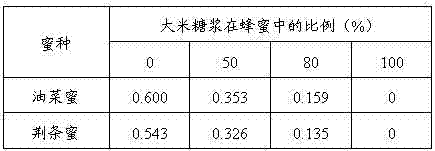Method for identifying genuine and fake honey
A honey, authenticity technology, applied in the field of food quality control, achieves the effects of low cost, simple operation, and suitable for popularization and application
- Summary
- Abstract
- Description
- Claims
- Application Information
AI Technical Summary
Problems solved by technology
Method used
Image
Examples
Embodiment 1
[0019] Collect fresh honey samples from the beehive during the flowering period of rape honey, linden honey, acacia honey, date nectar, wattle honey, longan honey, and lychee honey. Take 1.00g different honey samples and rice syrup samples, and use citric acid-phosphoric acid. The volume of disodium hydrogen buffer is made up to a 10 ml volumetric flask. Pipette 1.0 ml crude enzyme solution and 1.0 ml 30 mM p-nitrophenyl-β-D-glucoside (pNPG) into a test tube, mix well, and heat in a 37 ℃ water bath for 1.5 hours. Immediately add 5.0 mL of 1 M Na to the reaction mixture heated in a water bath 2 CO 3 The stop solution terminates the reaction, and the absorbance is measured at a wavelength of 400 nm after cooling to room temperature. In addition, take the reaction solution under the same conditions and immediately heat it in a boiling water bath for 5 minutes, and add 5.0 mL 1 M Na after inactivation 2 CO 3 Solution, as a blank control. The results are shown in Table 1.
[0020] T...
Embodiment 2
[0024] The rape honey and acacia honey were stored at room temperature for different periods of time, and 1.00 g of different honey samples and rice syrup samples were taken, and the volume was adjusted to a 10 ml volumetric flask with citric acid-disodium hydrogen phosphate buffer. Pipette 1.0 ml crude enzyme solution and 1.0 ml 30 mM p-nitrophenyl-β-D-glucoside (pNPG) into a test tube, mix well, and heat in a 37 ℃ water bath for 1.5 hours. Immediately add 5.0 mL of 1 M Na to the reaction mixture heated in a water bath 2 CO 3 The stop solution terminates the reaction, and the absorbance is measured at a wavelength of 400 nm after cooling to room temperature. In addition, take the reaction solution under the same conditions and immediately place it in a boiling water bath and heat it for 5 minutes, then add 5.0mL 1 M Na 2 CO 3 Solution, as a blank control. The results are shown in Table 2.
[0025] Table 2 β-glucosidase activity (U / g) in honey stored at room temperature for diff...
Embodiment 3
[0029] Mix 0%, 50%, 80%, and 100% rice syrup in Vitex nectar and rape honey respectively. Take 1.00 g of each sample and dilute to a 10 ml volumetric flask with citric acid-disodium hydrogen phosphate buffer. Pipette 1.0 ml crude enzyme solution and 1.0 ml 30 mM p-nitrophenyl-β-D-glucoside (pNPG) into a test tube, mix well, and heat in a 37 ℃ water bath for 1.5 hours. Immediately add 5.0 mL of 1 M Na to the reaction mixture heated in a water bath 2 CO 3 The stop solution terminates the reaction, and the absorbance is measured at a wavelength of 400 nm after cooling to room temperature. In addition, take the reaction solution under the same conditions and immediately place it in a boiling water bath and heat it for 5 minutes, then add 5.0mL 1 M Na 2 CO 3 Solution, as a blank control. The results are shown in Table 3.
[0030] Table 3 β-glucosidase activity in honey mixed with rice syrup in different proportions (unit U / g)
[0031]
[0032] It can be seen from Table 3 that as the c...
PUM
 Login to View More
Login to View More Abstract
Description
Claims
Application Information
 Login to View More
Login to View More - R&D
- Intellectual Property
- Life Sciences
- Materials
- Tech Scout
- Unparalleled Data Quality
- Higher Quality Content
- 60% Fewer Hallucinations
Browse by: Latest US Patents, China's latest patents, Technical Efficacy Thesaurus, Application Domain, Technology Topic, Popular Technical Reports.
© 2025 PatSnap. All rights reserved.Legal|Privacy policy|Modern Slavery Act Transparency Statement|Sitemap|About US| Contact US: help@patsnap.com

